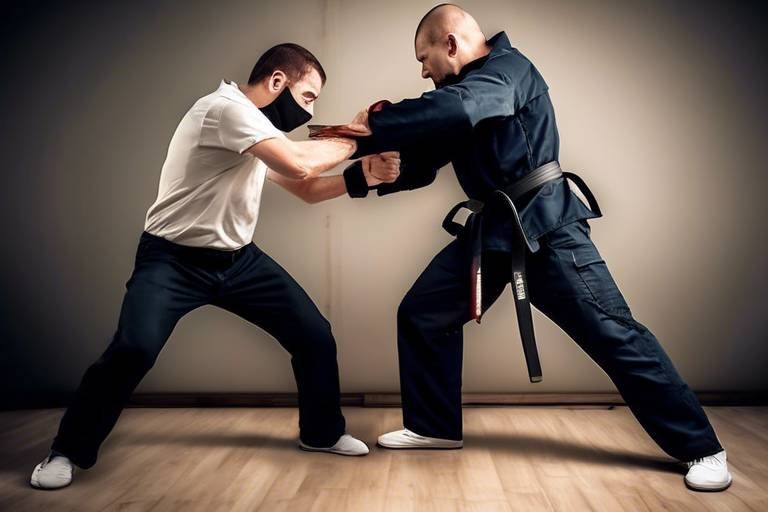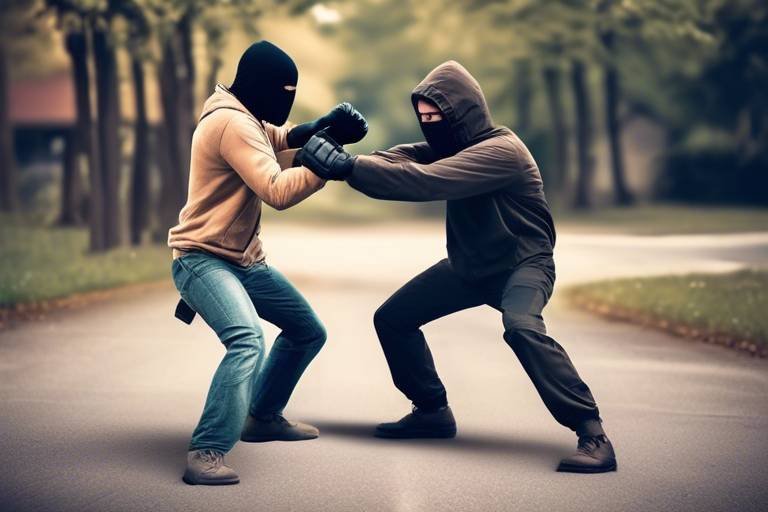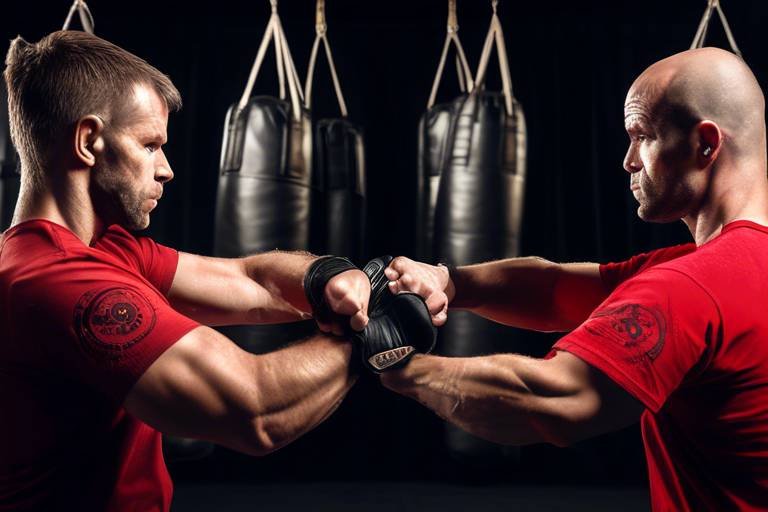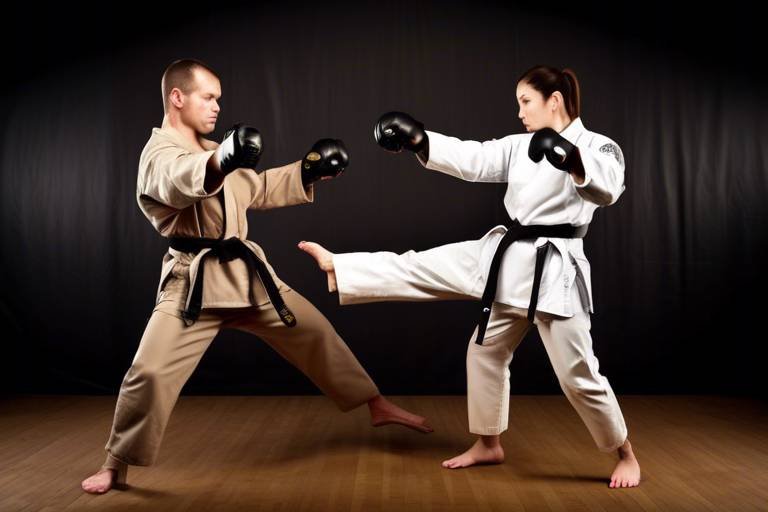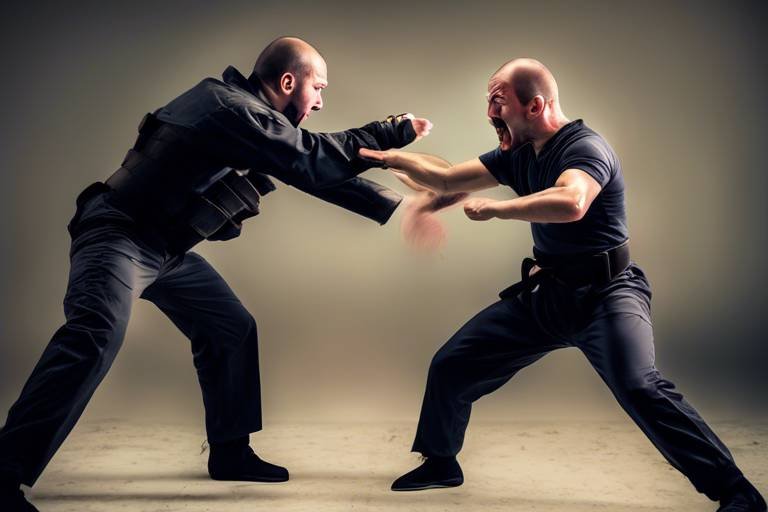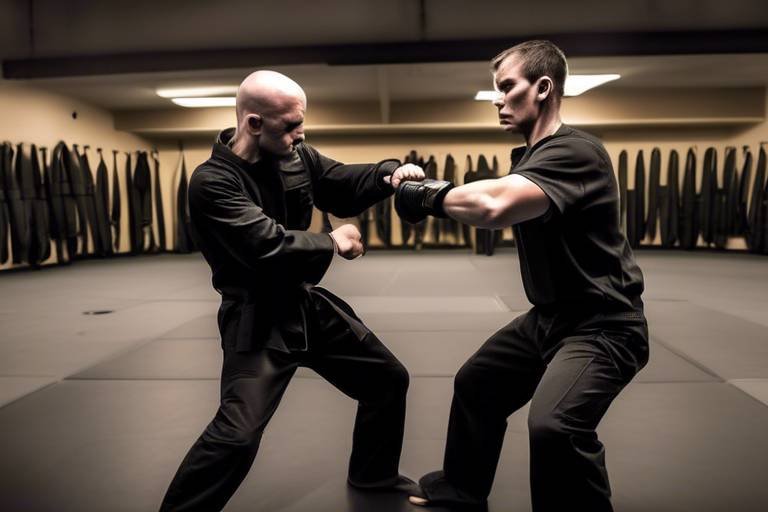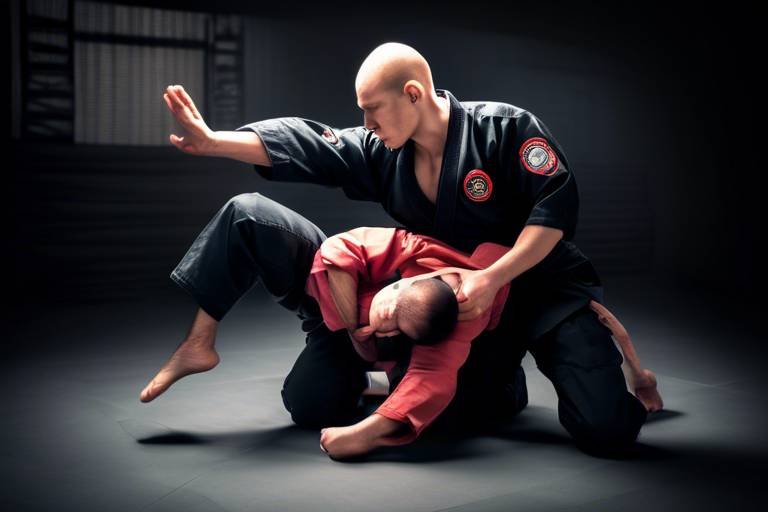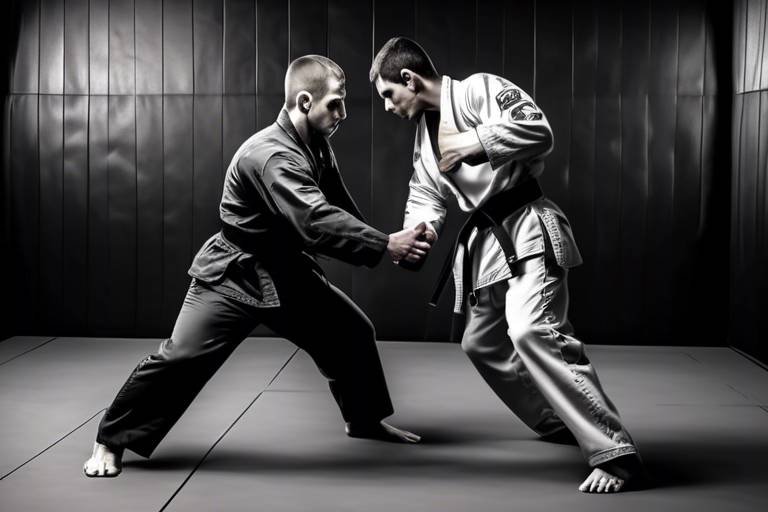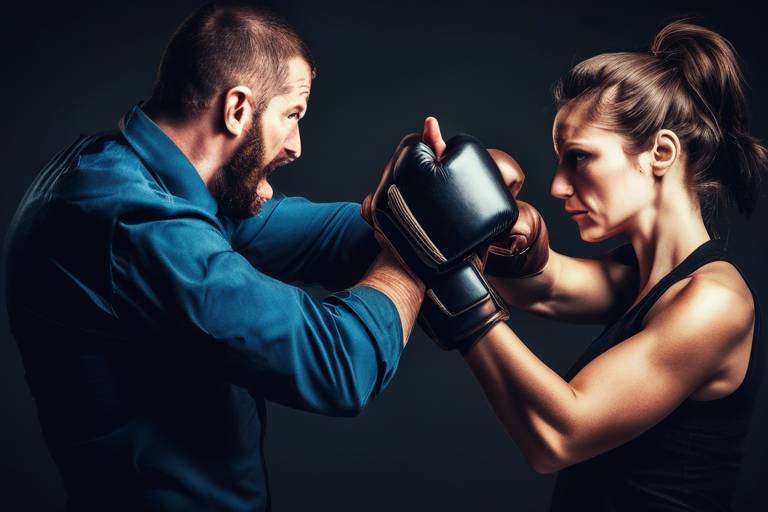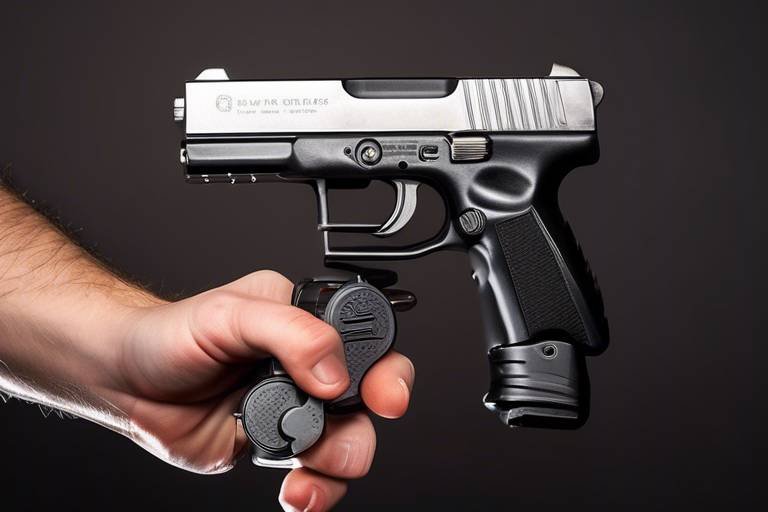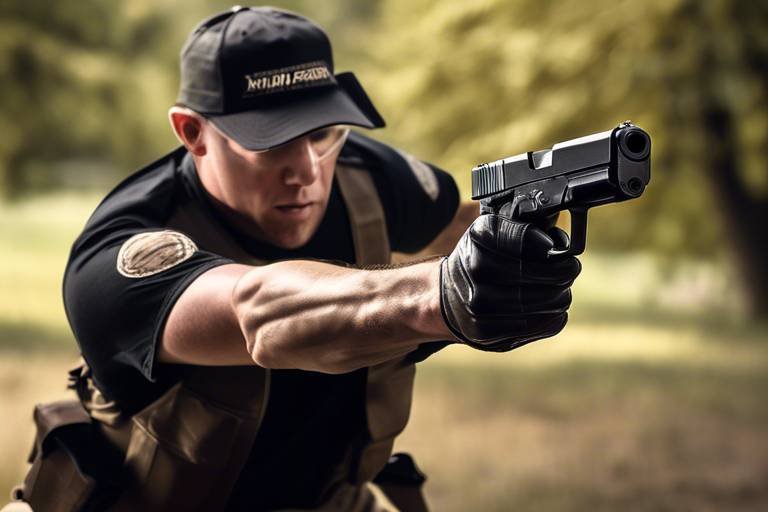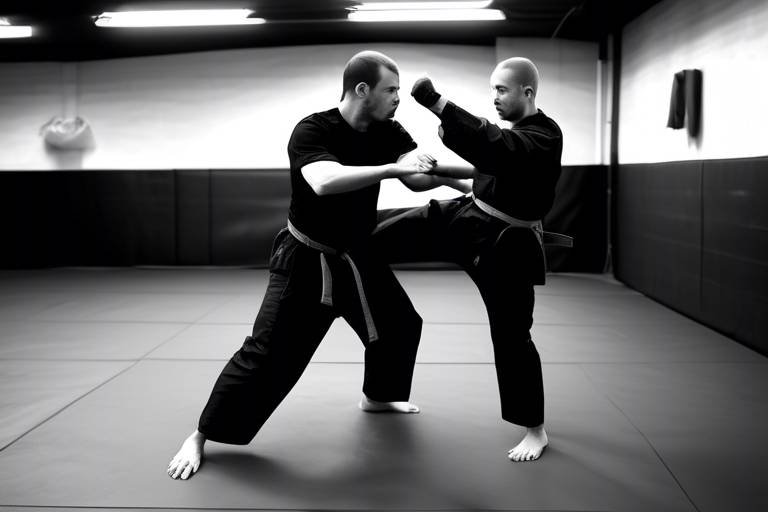How to Use Self-Defense Techniques Effectively Against Knife Attacks?
In today's world, the unsettling reality is that knife attacks can happen anywhere, anytime. The key to survival lies not just in physical strength but in a combination of awareness, strategy, and mental preparedness. This article serves as your guide to navigating this complex and potentially dangerous situation. We’ll explore essential self-defense techniques that can empower you to respond effectively when faced with a knife-wielding attacker. Remember, it's not just about fighting back; it's about being prepared and knowing how to protect yourself in the first place.
Knife attacks can vary widely in their nature, motivations, and the contexts in which they occur. Understanding these factors is crucial for anyone looking to enhance their self-defense skills. For instance, some attacks may stem from personal disputes, while others could be random acts of violence. Recognizing the warning signs—such as aggressive body language or an individual acting erratically—can be the difference between avoiding an encounter and facing a dire situation. Common scenarios include:
- Street confrontations
- Domestic disputes
- Robberies or muggings
By familiarizing yourself with these scenarios, you can better prepare yourself mentally and physically, ensuring that you are ready to act if the need arises.
Enhancing your situational awareness is one of the most effective ways to protect yourself from knife attacks. This involves being conscious of your surroundings, recognizing potential threats before they escalate, and understanding the environment around you. Ask yourself questions like: "Are there exits nearby?" or "Is anyone acting suspiciously?" Simple practices, such as maintaining eye contact with those around you and avoiding distractions like your phone, can significantly improve your ability to detect danger early.
When faced with a knife attack, knowing some basic self-defense techniques can be vital. These techniques focus on defensive postures, movement strategies, and methods to disable an attacker while minimizing your own risk of injury. Here are a few fundamental techniques:
- Defensive Posture: Keep your hands up and open, ready to deflect or block an attack.
- Movement: Stay mobile; sidestep or retreat to avoid the knife.
- Counter Techniques: If necessary, target vulnerable areas of the attacker, such as the eyes or throat.
Remember, the goal is to create an opportunity to escape rather than engage in a prolonged confrontation.
Believe it or not, everyday objects can serve as effective improvised weapons in a knife attack scenario. Items such as pens, keys, or even a rolled-up magazine can be used to defend yourself. Here’s how:
- Pens: Can be thrust into pressure points or the eyes.
- Keys: Used to scratch or jab at the attacker.
- Umbrellas: Can be wielded to create distance or block attacks.
Being resourceful and thinking quickly can turn the tide in a dangerous situation.
Not every confrontation needs to end in physical violence. Learning effective verbal and non-verbal de-escalation techniques can help diffuse a potentially violent situation. Use a calm voice, maintain open body language, and try to engage the aggressor in conversation. Sometimes, simply acknowledging their feelings can help to lower the tension. Remember, your primary goal is to prioritize safety and resolve the conflict without resorting to physical confrontation.
Regular training and practice are essential for anyone serious about self-defense. Consider enrolling in self-defense classes, attending workshops, or utilizing online resources to hone your skills. The more familiar you become with techniques and strategies, the more instinctual your responses will be in a real-life situation. Consistency is key; even a few hours a month can make a significant difference in your confidence and ability to react effectively.
Before you engage in any self-defense action, it's crucial to understand the legal implications. Laws regarding self-defense can vary significantly based on your location. Familiarize yourself with local laws to ensure that your actions are justified. Remember, using physical force comes with responsibilities, and being informed can help protect you legally after an incident.
Lastly, let's talk about the mental aspect of self-defense. Being psychologically prepared for a knife attack is just as important as physical readiness. Cultivating a mindset of confidence and decisiveness can help you react more effectively under pressure. Visualization techniques—imagining how you would respond in various scenarios—can also be beneficial. Think of it like training for a big game; the more mentally prepared you are, the better you will perform when it counts.
Q: What should I do if someone approaches me with a knife?
A: Stay calm, assess the situation, and if possible, try to escape. If you cannot escape, use defensive techniques to protect yourself while looking for an opportunity to flee.
Q: Can I use self-defense techniques if I feel threatened?
A: Yes, self-defense laws typically allow you to protect yourself if you genuinely feel threatened, but be aware of the legal implications in your area.
Q: How can I find self-defense classes near me?
A: Search online for local martial arts studios, community centers, or self-defense workshops. Many offer beginner classes tailored to various skill levels.
Q: What if I am not physically strong?
A: Self-defense is not just about physical strength; it's about technique, strategy, and awareness. Many self-defense techniques can be effective regardless of your size or strength.

Understanding Knife Attacks
Knife attacks are unfortunately a reality in today's world, and understanding them is the first step toward effective self-defense. These attacks can vary greatly in nature, and knowing the different types can significantly enhance your preparedness. For instance, a surprise attack might occur when an assailant approaches you without warning, while a confrontational attack often involves a verbal dispute escalating into violence. Recognizing these scenarios can help you remain vigilant and proactive.
Motivations behind knife attacks can also differ. Some attackers may be driven by desperation, seeking to steal valuables, while others may be fueled by anger or revenge. Understanding these motivations can provide insight into the mindset of an attacker, allowing you to anticipate their actions. Additionally, common locations for knife attacks often include dark alleys, bars, or even public transportation. Knowing where these incidents are likely to occur can help you avoid dangerous situations altogether.
It's essential to recognize that knife attacks can happen to anyone, regardless of age, gender, or background. This realization underscores the importance of being prepared. Consider the following warning signs that might indicate a potential knife attack:
- Increased aggression or agitation from an individual
- Someone holding a knife in a threatening manner
- Unusual behavior or movements that seem suspicious
By being aware of these signs and understanding the nature of knife attacks, you can better equip yourself to handle such dangerous situations. Remember, the goal is not to engage in combat but to escape safely. Awareness and preparation are your best allies in these tense moments.

Situational Awareness
Situational awareness is a crucial skill that can significantly enhance your personal safety, especially in potentially dangerous situations like a knife attack. Imagine walking through a bustling city street, your mind preoccupied with daily tasks, when suddenly, you notice a figure lingering too long in the shadows. This is where situational awareness comes into play—it’s your ability to perceive and interpret your environment, allowing you to react appropriately to threats.
To develop effective situational awareness, you need to cultivate a habit of observing your surroundings. Start by scanning your environment regularly. Are there people acting suspiciously? Is someone following you? By asking these questions, you train your brain to notice details that might otherwise go unnoticed. Think of it like being a detective in your own life—always on the lookout for clues that could indicate danger.
One of the key components of situational awareness is recognizing warning signs. These can include:
- Unusual behavior from individuals, such as excessive fidgeting or looking around nervously.
- Proximity to potential threats; for example, if someone is getting too close for comfort.
- Environmental cues, like broken glass or abandoned belongings that could indicate a recent struggle.
Understanding your environment is equally important. Familiarize yourself with the places you frequent. Know where the exits are, identify potential escape routes, and keep an eye on locations that provide cover. For instance, if you’re in a restaurant, note where the exits are and how to reach them quickly. This mental mapping can be a lifesaver in emergencies.
Moreover, don’t underestimate the power of intuition. If something feels off, trust your gut. It’s often our subconscious picking up on cues we may not consciously recognize. If you feel uncomfortable in a situation, it’s perfectly okay to remove yourself from it. Remember, being aware is not just about seeing; it’s about understanding the context and your place within it.
Lastly, practicing mindfulness can greatly improve your situational awareness. By being present in the moment, you enhance your ability to notice changes in your environment and the behavior of those around you. Consider incorporating mindfulness exercises into your daily routine, such as meditation or focused breathing, to sharpen your awareness skills.
In summary, situational awareness is about being proactive rather than reactive. It’s about training your mind to recognize threats and respond quickly and effectively. By honing this skill, you not only protect yourself from potential knife attacks but also empower yourself to navigate the world with greater confidence and security.
Q1: What is situational awareness?
A1: Situational awareness is the ability to perceive and understand what is happening around you, especially in potentially dangerous situations. It involves recognizing threats and understanding the context of your environment.
Q2: How can I improve my situational awareness?
A2: You can enhance your situational awareness by regularly scanning your environment, recognizing warning signs, familiarizing yourself with your surroundings, trusting your intuition, and practicing mindfulness techniques.
Q3: Why is situational awareness important for self-defense?
A3: Situational awareness is crucial for self-defense because it allows you to identify potential threats before they escalate, giving you time to react appropriately and avoid dangerous situations.

Basic Self-Defense Techniques
When it comes to protecting yourself from a knife attack, understanding can be a game changer. The reality is that facing an armed attacker can be terrifying, but being prepared can significantly increase your chances of survival. In this section, we will delve into some fundamental techniques that can help you defend yourself effectively while minimizing the risk of injury.
First and foremost, it’s vital to adopt a defensive posture. This means positioning your body in a way that allows you to react quickly and effectively. Keep your hands up, palms facing outward, and maintain a slight bend in your knees. This stance not only protects your vital areas but also prepares you to move swiftly in any direction. Think of it as a ready stance in a sport; you're poised, alert, and ready to respond.
One of the most crucial aspects of self-defense is movement. When confronted with a knife-wielding attacker, your goal should be to create distance. Remember, the closer the attacker is, the more dangerous they become. Use lateral movement—side stepping and circling—to avoid being in a straight line with the weapon. This can make it harder for the attacker to reach you effectively and gives you a better position to escape or counter.
Now, let’s talk about disarming techniques. While it’s not recommended to engage physically unless absolutely necessary, knowing how to disarm an attacker can be invaluable. One effective method is to use the attacker’s own momentum against them. For instance, if they lunge towards you, you can sidestep and use your arm to redirect their hand away from you, potentially causing them to stumble. However, this requires practice and should only be attempted if you have a solid understanding of the technique.
In situations where escape isn't an option, you might need to focus on targeting vulnerable areas. If you find yourself in a physical confrontation, aim for sensitive spots such as the eyes, throat, or groin. A quick jab to the eyes or a strike to the throat can create an opening for you to escape. Remember, the goal is not to engage in a prolonged fight but to create an opportunity to get away safely.
It’s also important to remain calm and focused. Panic can cloud your judgment, making it harder to execute your techniques effectively. Practicing mindfulness and stress-relief techniques can help you maintain composure in high-pressure situations. Visualizing potential scenarios can also prepare your mind for how to react, almost like rehearsing for a play.
Lastly, consider the environment around you. Sometimes, using your surroundings can provide an advantage. For example, if you’re near a wall or a sturdy object, you can use it to shield yourself or create a barrier between you and the attacker. Being aware of your surroundings and thinking creatively can enhance your chances of escaping safely.
In summary, mastering basic self-defense techniques requires not just physical practice but also mental preparedness. By understanding how to position yourself, move effectively, and respond to an attack, you can significantly improve your chances of staying safe in a dangerous situation. Remember, the ultimate goal is to escape unharmed, so focus on creating opportunities for yourself to get away.
- What should I do if I can't escape? If escape is not an option, focus on defending yourself by targeting vulnerable areas and looking for opportunities to disarm the attacker.
- Are self-defense classes worth it? Absolutely! Self-defense classes provide hands-on training and can boost your confidence, making you more prepared for potential threats.
- Can everyday items be used for self-defense? Yes, many common items can serve as improvised weapons, such as keys, pens, or even a handbag.
- How can I improve my situational awareness? Regularly practice being aware of your surroundings, noting exits, and recognizing potential threats in different environments.

Using Everyday Objects
When faced with the terrifying reality of a knife attack, your instincts kick in, and you may find yourself looking for anything that can help you defend yourself. The good news is that you don’t need to be a martial arts expert to protect yourself; often, the simplest items around you can serve as effective tools for self-defense. Think of everyday objects not just as mundane items, but as potential lifesavers. In the heat of the moment, your creativity and quick thinking can turn these objects into improvised weapons.
For instance, consider a pen. It may seem harmless, but wielded with purpose, it can be used to strike vulnerable areas of an attacker, such as the eyes or throat. Similarly, a keychain can be transformed into a makeshift weapon. By holding it between your fingers, you can create a defensive barrier that can inflict pain and create an opportunity to escape. Even a water bottle can serve a dual purpose; not only can it be used to throw at an assailant to distract them, but it can also be used to block a knife thrust.
Here’s a quick list of common items that can be utilized effectively in a self-defense situation:
- Umbrella: A sturdy umbrella can be used to block or deflect an attack.
- Backpack: Swinging a backpack can create distance and provide a barrier between you and the attacker.
- Cell Phone: As a last resort, throwing your phone can distract an attacker, giving you time to escape.
It’s essential to remember that the effectiveness of these objects relies on your ability to think quickly and act decisively. In a tense situation, even the most mundane item can become a powerful tool in your defense arsenal. Training yourself to recognize and utilize these items in a self-defense scenario can significantly increase your chances of escaping unharmed.
Moreover, practicing how to use these everyday objects in a safe environment can build your confidence. Role-playing scenarios with friends or attending self-defense workshops that incorporate the use of improvised weapons can provide invaluable experience. By familiarizing yourself with these techniques, you’ll be better prepared to react under pressure, turning the ordinary into extraordinary means of self-defense.

De-escalation Strategies
When faced with a potentially violent situation, the ability to de-escalate can be a game changer. Imagine walking into a room where tensions are high, voices are raised, and the air feels thick with anxiety. Instead of jumping straight into a confrontation, employing effective can turn a volatile situation into a peaceful resolution. It’s like being a calm lighthouse in a stormy sea, guiding the ship to safety rather than letting it crash on the rocks.
First and foremost, it’s essential to maintain a calm demeanor. Your body language speaks volumes, and projecting calmness can influence the behavior of those around you. Stand tall but relaxed, keep your hands visible, and avoid crossing your arms, which can be perceived as defensive. The goal here is to create an atmosphere of safety, allowing the other party to feel less threatened. Remember, a smile can sometimes diffuse tension—it's disarming in the best possible way!
Next, active listening plays a crucial role in de-escalation. When someone is upset, they often just want to be heard. Instead of interrupting or countering their points, try to listen actively. Nod your head, maintain eye contact, and occasionally paraphrase what they’re saying to show you understand. This not only validates their feelings but also opens the door for a more constructive dialogue. You might say something like, “I can see that you’re really frustrated about this situation.” This acknowledgment can work wonders.
Additionally, verbal techniques can be highly effective. Using a soft tone and simple language helps to lower the emotional temperature of the conversation. Phrases like “Let’s take a moment to breathe” or “I think we can find a solution together” can shift the focus from confrontation to collaboration. It’s all about steering the conversation away from aggression and towards understanding. In some cases, you might even consider using humor—if appropriate—to lighten the mood, but be cautious; humor can be a double-edged sword if not used wisely.
In situations where you feel threatened, it’s crucial to set boundaries. Clearly communicate what behavior is unacceptable while remaining respectful. For example, you might say, “I’m here to talk, but I need you to lower your voice so we can have a productive conversation.” This not only asserts your position but also encourages them to reflect on their actions.
Sometimes, it’s necessary to create physical space. If you sense that the situation is escalating, stepping back can help. This doesn’t mean you’re backing down; rather, you’re giving both parties the room to breathe and think. It’s similar to giving a pressure cooker a moment to release steam before it explodes. Physical distance can often reduce the intensity of emotions and allow for a more rational discussion.
Lastly, if all else fails, knowing when to walk away is a powerful strategy in itself. If the situation becomes too heated and you feel unsafe, it’s perfectly acceptable to disengage. You might say, “I think it’s best if we take a break and revisit this later.” Walking away doesn’t signify defeat; instead, it shows wisdom and foresight, prioritizing safety over pride.
In summary, mastering de-escalation strategies can significantly reduce the likelihood of violence in tense situations. By remaining calm, listening actively, using respectful language, setting boundaries, creating space, and knowing when to walk away, you equip yourself with the tools to navigate conflicts effectively. Just like a skilled negotiator, your role is to facilitate understanding and foster a peaceful resolution—even in the face of potential danger.
- What is de-escalation? De-escalation is the process of reducing the intensity of a conflict or potentially violent situation through communication and calming techniques.
- How can I practice de-escalation strategies? You can practice these strategies through role-playing scenarios, attending workshops, or even by observing and reflecting on your interactions with others.
- Are de-escalation techniques effective in all situations? While they can be very effective, some situations may require immediate action or intervention. Always prioritize your safety and the safety of others.
- Can humor really help in tense situations? Yes, humor can lighten the mood, but it must be used carefully and appropriately to avoid further aggravating the situation.

Training and Practice
When it comes to self-defense, especially against knife attacks, the importance of training and practice cannot be overstated. Imagine being in a high-stress situation where your instincts kick in, but you haven't prepared your body and mind to respond effectively. It's like trying to run a marathon without ever having trained for it; the outcome can be disastrous. Regular training not only builds your physical skills but also enhances your mental preparedness, allowing you to react swiftly and confidently when faced with a threat.
One of the best ways to hone your self-defense skills is through dedicated classes that focus on real-life scenarios. Look for local martial arts studios or community centers that offer self-defense workshops. These classes often provide hands-on experience with instructors who can guide you through various techniques tailored specifically for knife defense. Not only will you learn how to defend yourself, but you’ll also gain valuable insights into the psychology of an attacker, which can be crucial in understanding their motivations and movements.
In addition to formal classes, consider incorporating practice drills into your routine. Consistency is key! Set aside time each week to practice the techniques you've learned. You can do this alone or with a partner. For instance, practicing defensive postures and movements can significantly improve your muscle memory, making it easier to react instinctively. Here's a simple drill you can try:
| Drill Name | Description | Duration |
|---|---|---|
| Shadow Defense | Practice your defensive moves in front of a mirror, focusing on form and technique. | 10 minutes |
| Partner Sparring | With a partner, simulate a knife attack and practice your defensive strategies. | 15 minutes |
| Situational Role-Play | Act out various scenarios where you might encounter a knife threat, focusing on your response. | 20 minutes |
Moreover, online resources can be a fantastic supplement to your training. Numerous websites and video platforms offer tutorials and instructional videos on self-defense techniques. However, it’s essential to discern credible sources from those that may promote unsafe practices. Look for content created by certified instructors or established martial arts organizations.
Another aspect of training that is often overlooked is the importance of mental rehearsal. Visualization techniques can be incredibly powerful. Spend a few minutes each day imagining yourself in a threatening situation and how you would respond. This mental practice can help reduce anxiety and improve your reaction time, as your brain becomes familiar with the scenarios.
Lastly, remember that self-defense training is not just about physical techniques; it’s also about developing a self-defense mindset. This means being aware of your surroundings, trusting your instincts, and understanding when to engage or disengage from a confrontation. The more you train, the more confident you’ll become in your ability to handle dangerous situations, which is a crucial element in protecting yourself effectively.
In summary, the journey of mastering self-defense techniques against knife attacks is an ongoing process. By committing to regular training, practicing diligently, utilizing available resources, and fostering a strong mental approach, you can significantly enhance your self-defense capabilities. Remember, the goal is not just to defend yourself but to do so effectively and safely.
- How often should I practice self-defense techniques? Aim for at least once a week, but daily practice can significantly enhance your skills.
- Can I learn self-defense online? Yes, but it's best to complement online learning with in-person training for practical experience.
- What should I do if I feel threatened? Trust your instincts, assess the situation, and try to de-escalate or escape if possible.

Legal Considerations
When it comes to self-defense, especially against knife attacks, understanding the legal implications is crucial. The laws surrounding self-defense can vary significantly from one jurisdiction to another, and being unaware of these laws can lead to serious consequences. In many places, the use of force is only justified when it is deemed necessary to prevent imminent harm. This means that if you find yourself in a situation where you must defend yourself, you must not only consider your actions but also how they will be perceived under the law.
For instance, the concept of proportionality plays a vital role in self-defense claims. This means that the level of force you use must be proportional to the threat you face. If someone approaches you with a knife, responding with lethal force may be seen as excessive unless you genuinely believe your life is in imminent danger. It’s important to remember that the law often scrutinizes the circumstances surrounding an incident, including:
- The severity of the threat
- Your ability to retreat or escape
- The presence of witnesses
- The overall context of the situation
In many jurisdictions, there is also a duty to retreat, meaning if you can safely escape the situation without using force, you are legally required to do so. However, some areas have "stand your ground" laws that allow individuals to use force without retreating, even if they could safely leave. This can lead to confusion, particularly for individuals who are not well-versed in local laws.
It’s also essential to be aware of the potential legal repercussions that can follow a self-defense incident. After an altercation, law enforcement will likely conduct an investigation, and your actions will be scrutinized. Documenting the incident as soon as possible, including taking notes about what happened, can be beneficial. If you have witnesses, gather their contact information as they may provide valuable testimony later.
Furthermore, if you do find yourself in a situation where you have had to defend yourself, seeking legal counsel is highly advisable. A lawyer who specializes in self-defense cases can offer guidance on how to navigate the legal system and help protect your rights. They can also assist in preparing your defense should any charges arise.
In summary, understanding the legal landscape surrounding self-defense is not just about knowing your rights; it’s about being prepared to act responsibly and knowledgeably in high-stress situations. Educating yourself on local laws, considering the implications of your actions, and consulting with legal professionals can make a significant difference in the aftermath of a self-defense incident.
- What should I do immediately after a self-defense incident? It's crucial to contact law enforcement, seek medical attention if necessary, and consult with a lawyer.
- Can I use self-defense if I provoke an attacker? Generally, if you provoke someone, your right to self-defense may be compromised. However, every situation is unique, and legal advice is recommended.
- Are there any legal repercussions for using self-defense? Yes, depending on the circumstances, you may face legal scrutiny. It’s important to understand the laws in your area.
- Do I need to carry a weapon for self-defense? No, self-defense can be effectively practiced without weapons. Focus on techniques and situational awareness.

Psychological Preparedness
When it comes to self-defense, is just as crucial as physical techniques. Imagine being in a high-stress situation where an attacker brandishes a knife. Your mind can either be your greatest ally or your worst enemy. So, how do you train your brain to react effectively in such scenarios? It's all about mindset, confidence, and decision-making under pressure.
First and foremost, let's talk about mindset. Having a proactive mindset can significantly enhance your ability to respond to threats. This means cultivating a mental state where you are always aware of your surroundings and prepared to act if necessary. Think of it as being a vigilant hawk, always scanning the environment. Practicing visualization techniques can help. Picture yourself in various scenarios where you might face a knife attack, and mentally rehearse your responses. This mental exercise can create a sense of familiarity, making it easier to react when the situation arises.
Next comes confidence. The more confident you are in your abilities, the less likely you are to freeze or panic. To build confidence, regular training is essential. Whether it's attending self-defense classes, practicing with friends, or even shadowboxing at home, every bit of practice adds to your self-assurance. Remember, confidence is contagious; when you believe in yourself, others will too. This can be especially beneficial in de-escalation situations where your assertiveness might prevent an attack altogether.
Now, let’s dive into decision-making. In a high-pressure situation, your brain can become overwhelmed with adrenaline, making it difficult to think clearly. This is where preparation comes into play. Familiarize yourself with the various self-defense techniques and understand when to apply them. In essence, create a mental flowchart of responses. For example, if an attacker approaches with a knife, your immediate reaction might be to create distance, then assess your surroundings for potential escape routes or improvised weapons. This structured thinking can help you respond more effectively when your instincts kick in.
Another vital aspect of psychological preparedness is understanding the emotional impact of a knife attack. It's not just about physical survival; the aftermath can be just as challenging. Many survivors experience anxiety, PTSD, or other emotional distress. Acknowledging this reality is crucial. Consider seeking professional help or joining support groups if you ever find yourself in such a situation. Mental health is just as important as physical health, and taking care of your mind will empower you to face future challenges with resilience.
In conclusion, psychological preparedness is an ongoing journey. It involves building a strong mindset, fostering confidence, and honing decision-making skills. By integrating these elements into your self-defense training, you can significantly enhance your ability to respond effectively to knife attacks. Remember, in the heat of the moment, your mind can either be your best weapon or your greatest hindrance. Choose to prepare it wisely!
- What is psychological preparedness in self-defense? It refers to the mental readiness to respond effectively to threats, focusing on mindset, confidence, and decision-making.
- How can I improve my situational awareness? Regularly practice scanning your environment, and engage in mental exercises that enhance your observational skills.
- Is training necessary for psychological preparedness? Yes, consistent training helps build confidence and familiarity with self-defense techniques, improving your overall response in emergencies.
- What should I do if I experience anxiety after a violent encounter? Seek professional help or join support groups to process your emotions and regain your mental strength.
Frequently Asked Questions
- What should I do if I encounter someone with a knife?
If you find yourself face-to-face with someone wielding a knife, your first instinct should be to prioritize your safety. Try to remain calm and assess the situation. Look for an escape route and consider de-escalation techniques to avoid confrontation. Remember, your goal is to get to safety, not to engage.
- Can self-defense techniques really help in a knife attack?
Absolutely! While no technique can guarantee your safety, learning self-defense can significantly increase your chances of effectively responding to a knife attack. Techniques focus on defensive maneuvers, movement strategies, and using your environment to your advantage, which can help you protect yourself.
- What are some everyday objects I can use for self-defense?
Everyday objects can serve as effective improvised weapons in a pinch. Items like keys, pens, or even a rolled-up magazine can be used to defend yourself. The key is to be creative and quick-thinking, using whatever is at hand to create distance or distract the attacker.
- How important is situational awareness in preventing knife attacks?
Situational awareness is crucial! By being aware of your surroundings and recognizing potential threats, you can often avoid dangerous situations altogether. Pay attention to your environment, and trust your instincts—if something feels off, it probably is.
- Is it legal to use self-defense techniques against a knife attack?
The legality of using self-defense varies by location. It's essential to understand your local laws regarding self-defense and the use of force. Generally, you can defend yourself if you feel threatened, but the response must be proportional to the threat. Always seek legal advice if you're unsure.
- How can I prepare mentally for a potential knife attack?
Mental preparedness is just as important as physical training. Practice visualization techniques and role-play scenarios to build confidence. Focus on maintaining a calm mindset and developing quick decision-making skills under pressure. Remember, staying composed can make all the difference in a crisis.
- What should I look for in self-defense training classes?
When choosing a self-defense class, look for experienced instructors who emphasize practical techniques and real-world scenarios. Classes should cover a variety of situations, including knife attacks, and offer hands-on practice. Don't forget to check reviews and ask about the curriculum to ensure it meets your needs.
- How often should I practice self-defense techniques?
Consistency is key! Regular practice helps reinforce techniques and builds muscle memory. Aim to practice at least once a week, whether in a class or through solo drills. The more familiar you are with the techniques, the more instinctive your responses will be in a real situation.

